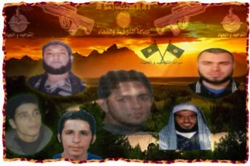
This image was created by or for Jama‘at al-Tawhid wal-Jihad (JTJ, or the Society for Monotheism and Jihad), which was initially led by Abu Mus‘ab al-Zarqawi, but which became part of the al-Qa‘ida network in Iraq in 2004 under the official name Tanzim Qa‘idat al-Jihad fi Bilad al-Rafidayn. The image encompasses a variety of elements that are designed to evoke a host of notions from within the Islamic tradition. At the top is a black banner bearing the group’s name and logo and two sub-machine guns. There is also an image of two crossed black flags (banners), a common symbol of engagement in battle. The image of the black flag has been used as a symbol of religious revolt and engagement in battle, i.e., defensive jihad. Under the two crossed flags appears the name “saraya al-tawhid wal-jihad” (“squadrons of Tawhid and Jihad”), and the flags are transposed on the setting sun in a manner that suggests the light is emerging from the squadrons.The image of the water path reflects the pivotal “path metaphor” in Islam and the idea that being righteous means following “a correct or straight path.” Hence, the river, in combination with other elements like the mountains, clouds, rays of light on the horizon and warriors’ faces, suggest the warriors’ righteous character and heavenly reward. Finally, the path/river leads to the emblem of the Tawhid, which suggests that the active participation in jihad by Tawhid’s members constitutes the right path.
 Skip to content
Skip to content
